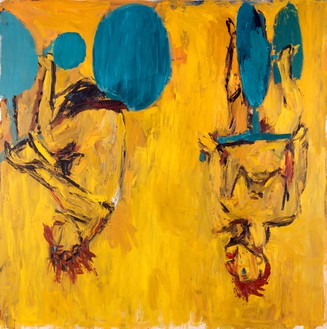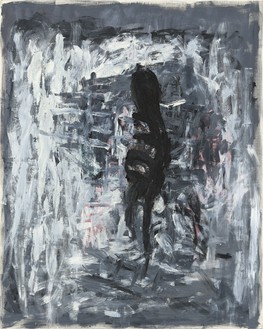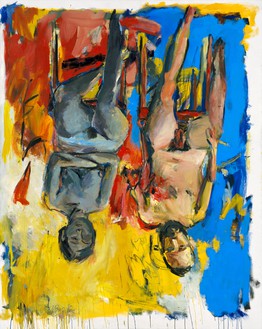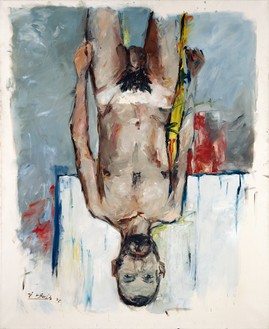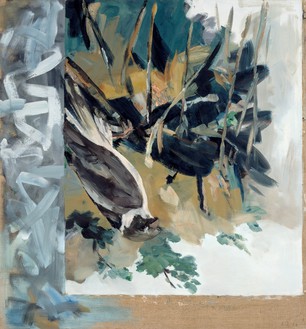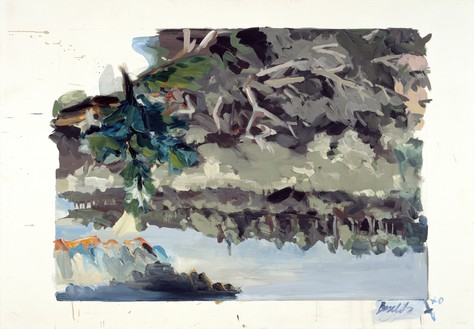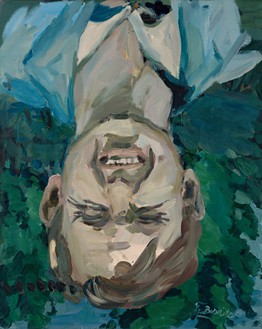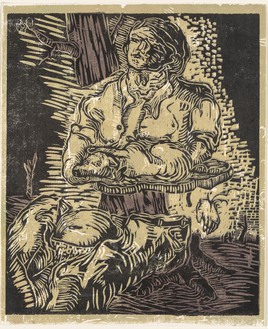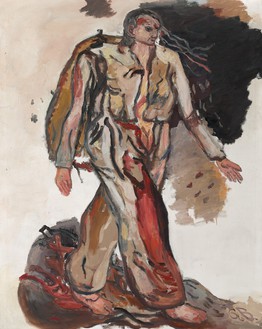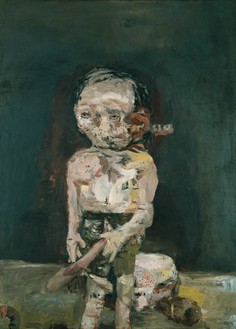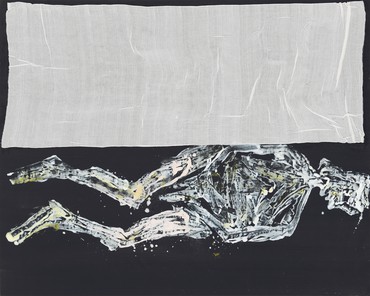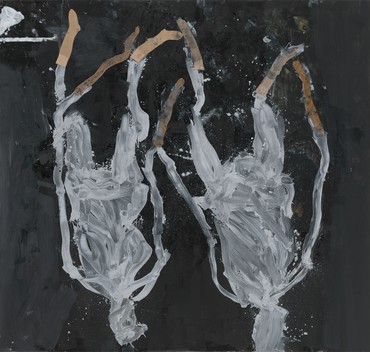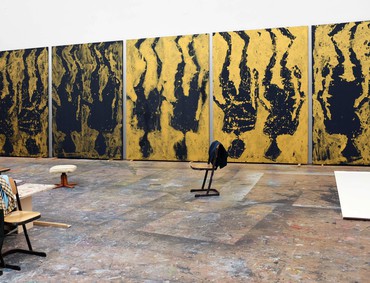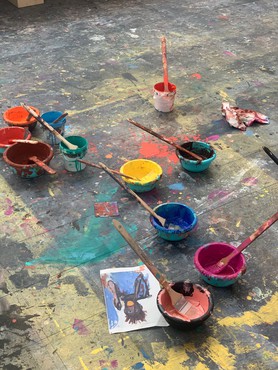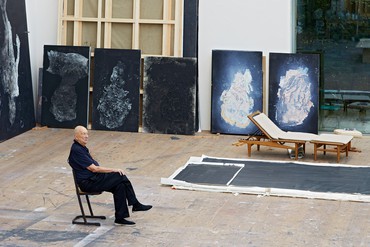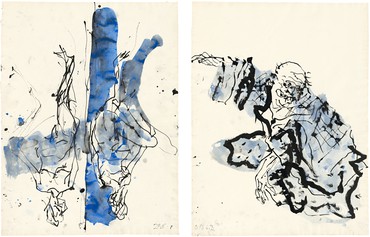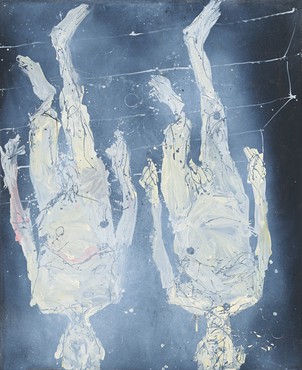About
This idea of “looking toward the future” is nonsense. I realized that simply going backwards is better. You stand in the rear of the train—looking at the tracks flying back below—or you stand at the stern of a boat and look back—looking back at what’s gone.
—Georg Baselitz
German painter, printmaker, and sculptor Georg Baselitz is a pioneering postwar artist who rejected abstraction in favor of recognizable subject matter, deliberately employing a raw style of rendering and a heightened palette in order to convey direct emotion. Embracing the German Expressionism that had been denounced by the Nazis, Baselitz returned the human figure to a central position in painting.
Born Hans-Georg Kern in Deutschbaselitz, Saxony, Germany, Baselitz attended the Hochschule für Bildende und Angewandte Kunst in East Berlin, from which he was expelled in 1957 for “sociopolitical immaturity.” He then moved to West Berlin, where he attended the Hochschule der Künste and completed his postgraduate studies in 1962. It was during this time that he changed his surname to Baselitz. From his youth, Baselitz had been interested in the German Expressionists’ use of “primitive” sources such as folk art, children’s art, and art of the mentally ill. To assert his independence from popular art of the postwar years, Baselitz and fellow artist Eugen Schönebeck wrote the so-called “Pandemonic Manifestos” (1960–62), a violent and shocking expression of the frustration of working in postwar Germany. In 1963 Baselitz had his first solo exhibition, which was an immediate scandal: the painting Die große Nacht im Eimer (The Big Night Down the Drain) (1962–63), depicting a distorted figure holding an oversized phallus, was removed from the exhibition due to charges of obscenity and not returned to Baselitz until the conclusion of a lengthy trial. In 1965 Baselitz turned to the subject of “heroes.” Painted in thick impasto, the Helden (Heroes) (1965–66)—also known as the Neue Typen (New Types)—portray figures standing within natural landscapes. Disheveled and fragmented, these war-torn figures elicit an emotional response in the viewer as they evoke the events of recent history.
In 1969 Baselitz began to paint and display his subjects upside down in order to slow down his process of painting as well as the viewer’s comprehension of the motif. These iconic paintings, depicting inverted figures, landscapes, and still lifes, achieve a form of abstraction while maintaining figuration. Through the 1980s, his work took on an added density as he further employed a wide range of formal and art historical references, including the paintings of Edvard Munch and Emil Nolde. Concurrently, he began creating large-scale sculptures made of painted wood, presenting these works for the first time at the 1980 Biennale di Venezia, where he showed Modell für eine Skulptur (Model for a Sculpture) (1979–80).
The paintings that Baselitz produced between 1990 and 2010 marked another shift in his practice, displaying a more linear and abstract approach to the figure. In the Remix series (2005–08), Baselitz revisited his earlier works, graphically re-presenting his prior subjects such that their subtle meanings and technical innovations were made more explicit. In 2015 Baselitz’s Avignon (2014) paintings—a suite of eight towering nude self-portraits—were featured in the Biennale di Venezia. The following year related self-portraits with spectral figures were presented at Gagosian, West 21st Street, New York. In 2018 a large retrospective of Baselitz’s work was presented at the Fondation Beyeler, Riehen/Basel, Switzerland, and at the Hirshhorn Museum and Sculpture Garden, Washington, DC.
Exhibitions
In Conversation
Georg Baselitz and Richard Calvocoressi
In conjunction with the exhibition The Painter in His Bed, at Gagosian, New York, Georg Baselitz and Richard Calvocoressi discuss the motif of the stag in the artist’s newest paintings.
Georg Baselitz: Archinto
On the occasion of Georg Baselitz: Archinto at Museo di Palazzo Grimani, Venice, Artcore Films produced a short documentary featuring the artist. In the video, Baselitz details the origins of the project, how he approached the unique space, and his experiments in process and technique.
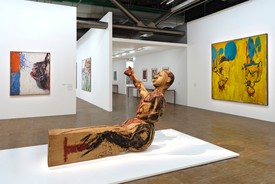
Baselitz: La rétrospective
Richard Calvocoressi visits Georg Baselitz’s retrospective exhibition at the Centre Pompidou in Paris and reflects on both the historical specificity and timeless themes of the artist’s sixty-year career.
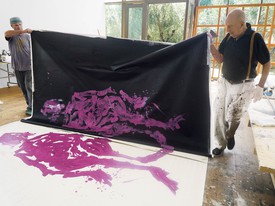
Georg Baselitz: Pulling Up the Image
In celebration of five recent projects related to Georg Baselitz, Richard Calvocoressi, Max Hollein, and Katy Siegel speak with the artist and look at his prolific career.
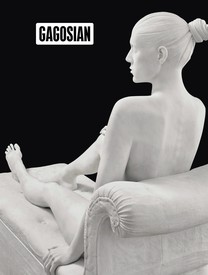
Now available
Gagosian Quarterly Fall 2021
The Fall 2021 issue of Gagosian Quarterly is now available, featuring Damien Hirst’s Reclining Woman (2011) on its cover.
Georg Baselitz: What if...
Richard Calvocoressi narrates a tour of an exhibition of new paintings by Georg Baselitz in San Francisco, describing the visual effect of these luminous compositions and explaining their relationship to earlier works by the artist.

Artist to Artist: Georg Baselitz and Zeng Fanzhi
On the occasion of Georg Baselitz: Years later at Gagosian, Hong Kong, Zeng Fanzhi composed a written foreword for the exhibition’s catalogue and a video message to the German painter. Baselitz wrote a letter of thanks to the Chinese artist for his insightful thoughts.
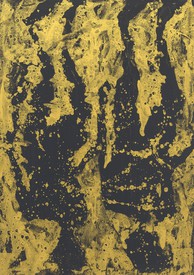
Georg Baselitz: Life, Love, Death
Richard Calvocoressi writes on the painter’s latest bodies of work, detailing the techniques employed and their historical precedents.
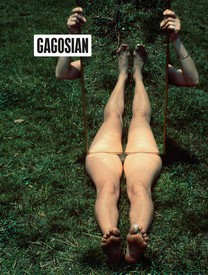
Now available
Gagosian Quarterly Summer 2020
The Summer 2020 issue of Gagosian Quarterly is now available, featuring Joan Jonas’s Mirror Piece 1 (1969) on its cover.
![Georg Baselitz, Ohne Titel (nach Pontormo) (Untitled [after Pontormo]), 1961.](https://gagosian.com/media/images/quarterly/essay-baselitz-bildung/qxhewJId3rEi_275x275.jpg)
Baselitz Bildung
On the occasion of a career-spanning exhibition at the Gallerie dell’Accademia, Venice, Richard Calvocoressi tracks the evolution of Georg Baselitz’s development from his early education in East Germany to his revelatory trip to Florence, in 1965, and beyond.
Visions of the Self: Jenny Saville on Rembrandt
Jenny Saville reveals the process behind her new self-portrait, painted in response to Rembrandt’s masterpiece Self-Portrait with Two Circles.
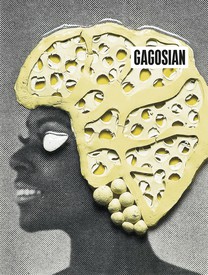
Now available
Gagosian Quarterly Summer 2019
The Summer 2019 issue of Gagosian Quarterly is now available, featuring a detail from Afrylic by Ellen Gallagher on its cover.
Fairs, Events & Announcements
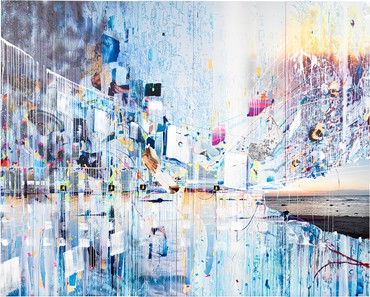
Art Fair
Art Basel Hong Kong 2024
March 27–30, 2024
Hong Kong Convention and Exhibition Centre
www.artbasel.com
Gagosian is participating in Art Basel Hong Kong 2024 with a selection of works by international contemporary artists. The works on view, which embrace a dizzying variety of subjects and approaches, see the participating artists identify fresh ways to disrupt established histories of abstraction and figuration, and instill sculptural and painterly representations of the natural world with complex cultural significance.
Sarah Sze, Turning and Turning, 2024 © Sarah Sze. Photo: Maris Hutchinson
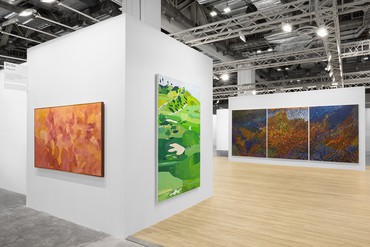
Art Fair
ART SG 2024
January 19–21, 2024, booth BC06
Marina Bay Sands Expo and Convention Centre, Singapore
artsg.com
Gagosian is pleased to participate in the second edition of ART SG, with a selection of works by international contemporary artists including Harold Ancart, Georg Baselitz, Ashley Bickerton, Amoako Boafo, Dan Colen, Edmund de Waal, Nan Goldin, Lauren Halsey, Hao Liang, Keith Haring, Damien Hirst, Tetsuya Ishida, Alex Israel, Donald Judd, Y.Z. Kami, Emily Kame Kngwarreye, Rick Lowe, Takashi Murakami, Takashi Murakami & Virgil Abloh, Nam June Paik, Ed Ruscha, Jim Shaw, Alexandria Smith, Spencer Sweeney, Stanley Whitney, Jonas Wood, and Zeng Fanzhi. The works on view, which embrace a wide variety of subjects and approaches, find artists infusing traditional genres such as history painting, portraiture, and landscape with new and surprising ideas that traverse cultural and temporal boundaries.
Gagosian’s booth at ART SG 2024. Artwork, left to right: © ADAGP, Paris, 2024, © Jonas Wood, © Rick Lowe Studio. Photo: Ringo Cheung
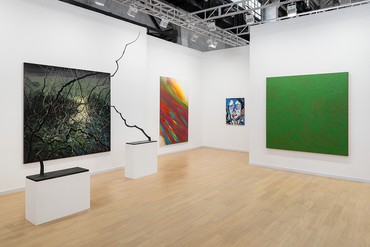
Art Fair
West Bund Art & Design 2023
November 9–12, 2023, booth A102
West Bund Art Center, Shanghai
www.westbundshanghai.com
Gagosian is pleased to participate in West Bund Art & Design with an extensive group presentation. The gallery will exhibit works by Harold Ancart, Georg Baselitz, Glenn Brown, Urs Fischer, Katharina Grosse, Hao Liang, Damien Hirst, Thomas Houseago, Alex Israel, Jia Aili, Anish Kapoor, Yayoi Kusama, Takashi Murakami, Takashi Murakami & Virgil Abloh, Albert Oehlen, Nam June Paik, Ed Ruscha, Alexandria Smith, Spencer Sweeney, Cameron Welch, Jonas Wood, and Zeng Fanzhi.
Gagosian’s booth at West Bund Art & Design 2023. Artwork, left to right: © Zeng Fanzhi; © Katharina Grosse and VG Bild-Kunst, Bonn, Germany 2023; © Spencer Sweeney; © Yayoi Kusama. Photo: Alessandro Wang
Museum Exhibitions
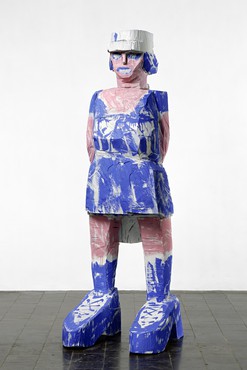
Opening Today
Georg Baselitz
Belle Haleine
April 27–November 24, 2024
Galleria degli Antichi, Sabbioneta, Italy
www.visitsabbioneta.it
Georg Baselitz: Belle Haleine features large-scale sculptures, paintings, and ten monumental linocuts by Baselitz installed along the Renaissance arches and under the frescoed ceilings of the Galleria degli Antichi in the UNESCO World Heritage site of Sabbioneta, Italy. In exhibiting his work within this setting, Baselitz aims to reveal the importance of Italian art history to his own artistic development, creating a confrontation between the contemporary and the past.
Georg Baselitz, Donna Via Venezia, 2004–06 © Georg Baselitz 2024. Photo: Jochen Littkemann
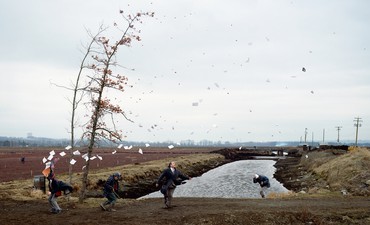
Closing this Week
Capturing the Moment
Through April 28, 2024
Tate Modern, London
www.tate.org.uk
Capturing the Moment explores the relationship between photography and painting through iconic artworks from the modern era. The exhibition examines how the two distinct mediums have shaped each other and how artists have blurred the boundaries to capture moments in time. Work by Francis Bacon, Georg Baselitz, John Currin, Andreas Gursky, Pablo Picasso, Jeff Wall, and Andy Warhol is included.
Jeff Wall, A Sudden Gust of Wind (after Hokusai), 1993, Tate Modern, London © Jeff Wall
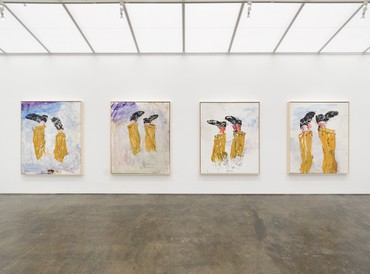
On View
Baselitz im Atelier
Open from April 7, 2023
Kunstmuseum Schloss Derneburg, Germany
www.hallartfoundation.org
Schloss Derneburg was Georg Baselitz’s home and studio for more than three decades until its sale to Andy and Christine Hall, founders of the Hall Art Foundation, in 2006. This exhibition, whose title translates to Baselitz in the Studio, includes some two dozen paintings and one sculpture that were completed between 1998 and 2005 and are among the last works the artist made in this studio. This is the first in a series of Baselitz exhibitions drawn from the Hall Collection that will be presented on the occasion of the artist’s eighty-fifth birthday.
Installation view, Baselitz im Atelier, Kunstmuseum Schloss Derneburg, Germany, open from April 7, 2023. Artwork © Georg Baselitz 2023. Photo: Roman März, courtesy Hall Art Foundation
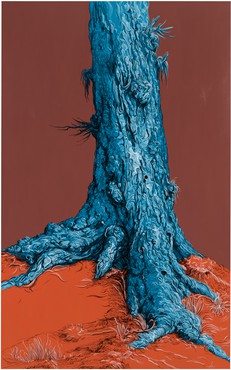
Closed
Dix und die Gegenwart
September 30, 2023–April 1, 2024
Deichtorhallen Hamburg, Germany
www.deichtorhallen.de
This exhibition, whose title translates to Dix and the Present, explores the work of Otto Dix (1891–1969) and the artist’s enduring influence. It focuses on the ostensibly apolitical work Dix created beginning in 1933, which was less aggressive than his radical and provocative paintings of the 1920s. His Nazi-era landscapes, commissioned portraits, and Christian allegories were instead subtle and subversive forms of contemporary social critique. The exhibition aims to reveal the shifting cultural and social parameters in the reception of Dix’s art, while also demonstrating how his oeuvre continues to fascinate more than forty contemporary artists. Work by Georg Baselitz, Glenn Brown, John Currin, Nan Goldin, and Anselm Kiefer is included.
Glenn Brown, The Holy Bible, 2022 © Glenn Brown
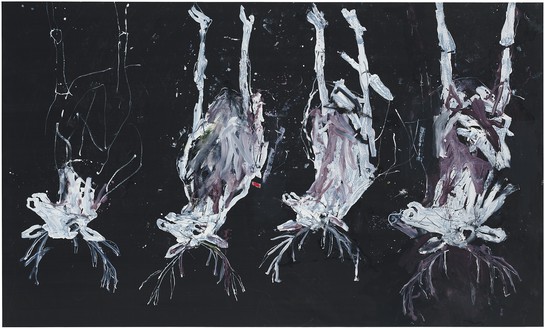
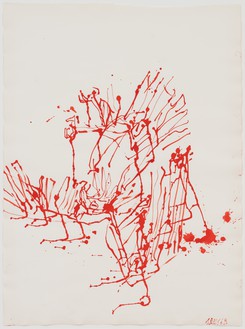
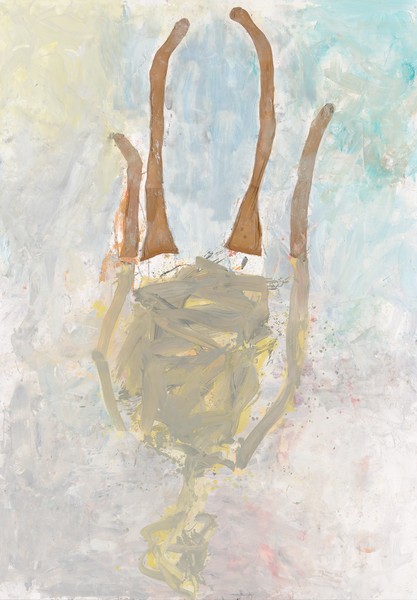
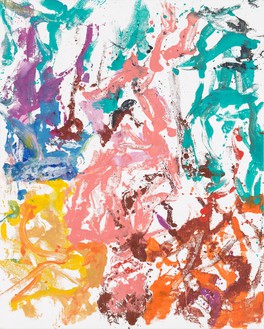
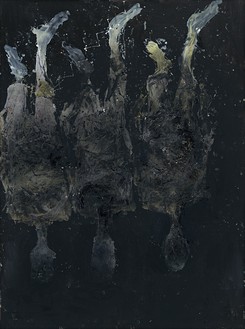
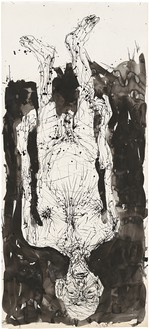
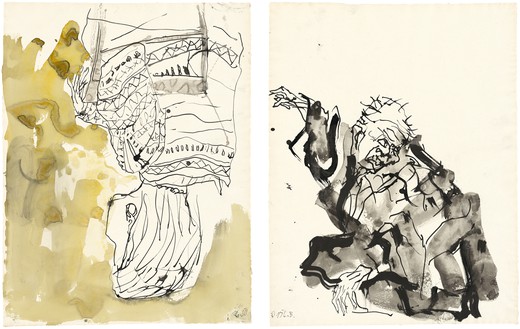
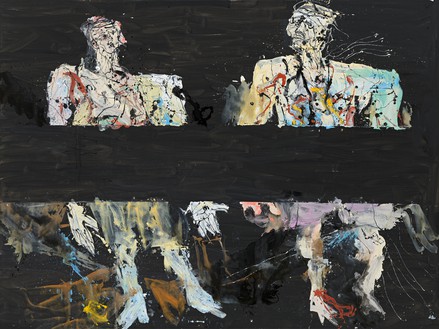
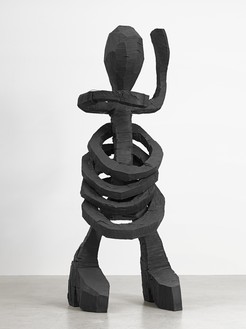
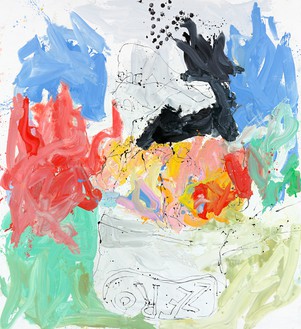
![Georg Baselitz, Franz Pforr Ganz Groß (Remix) (Franz Pforr Very Big [Remix]), 2006 Oil on canvas, 118 ⅛ × 157 ½ inches (300 × 400 cm)© Georg Baselitz](https://gagosian.com/media/images/artists/georg-baselitz/a-bc4EuUE7TN_585x329.jpg)
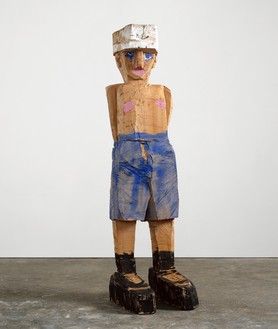
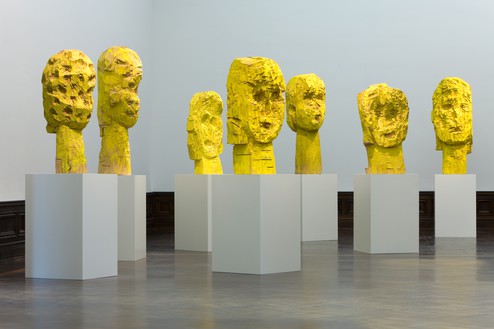
![Georg Baselitz, Orangenesser (IX) (Orange Eater [IX]), 1981 Oil and tempera on canvas, 57 ½ × 44 ⅞ inches (146 × 114 cm)© Georg Baselitz, 2018. Photo: Friedrich Rosenstiel, Köln](https://gagosian.com/media/images/artists/georg-baselitz/OjZwYEPi3Kxa_585x329.jpg)
